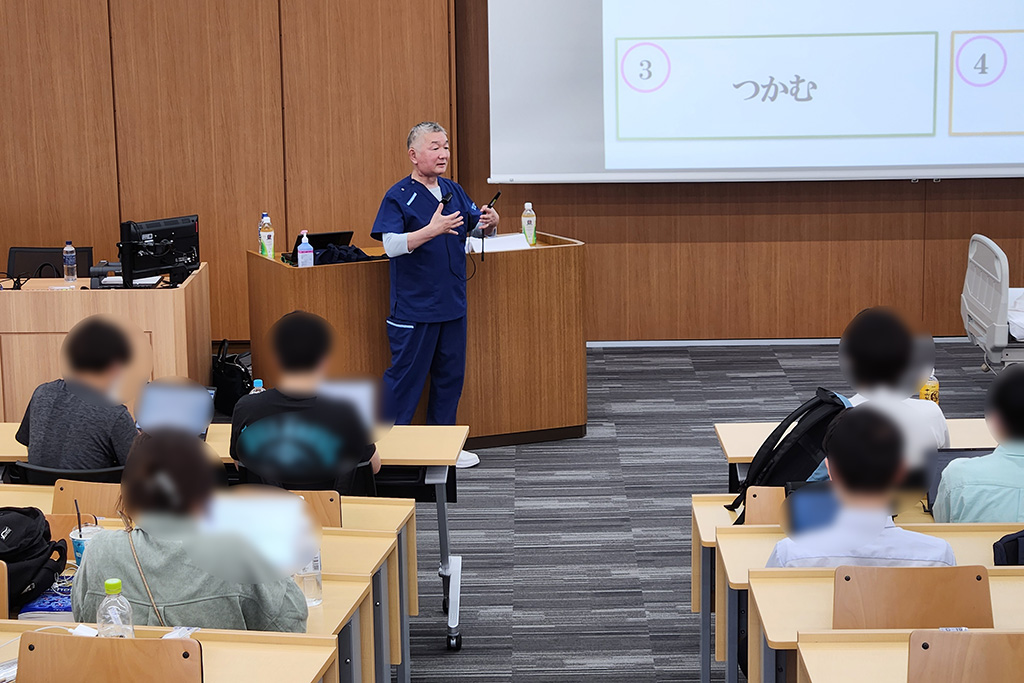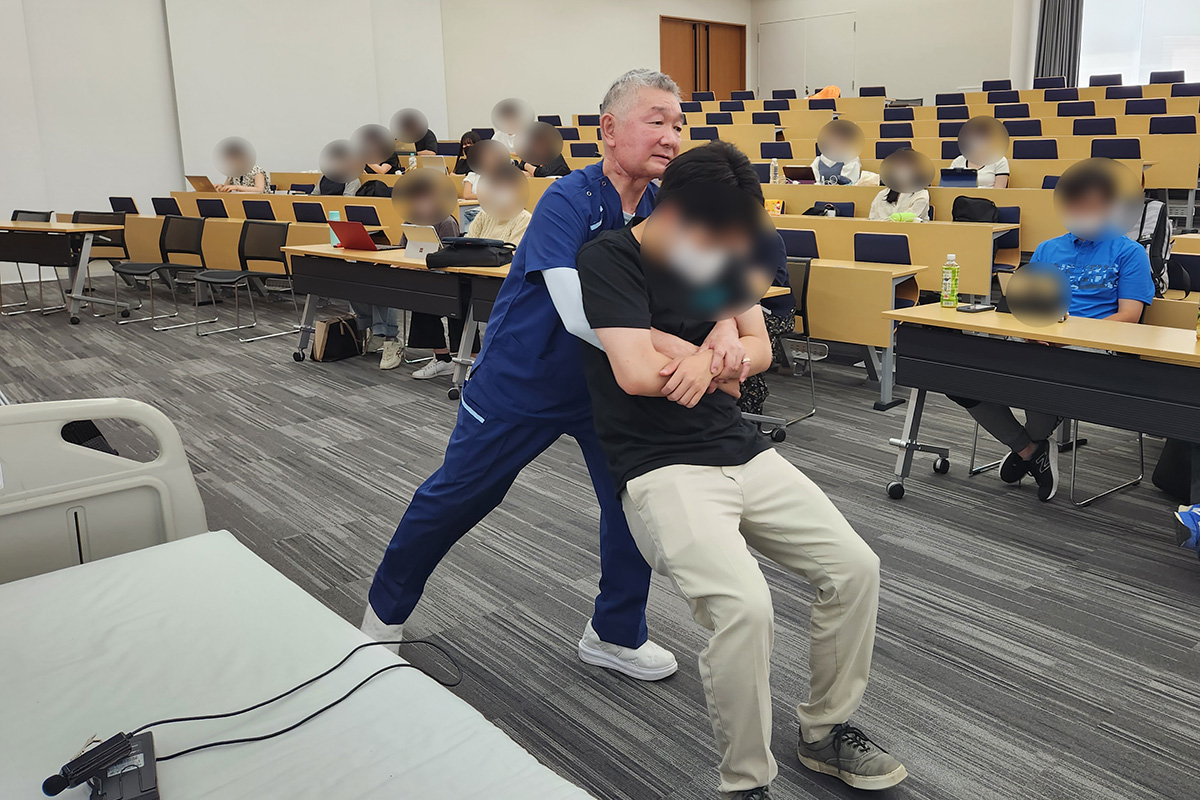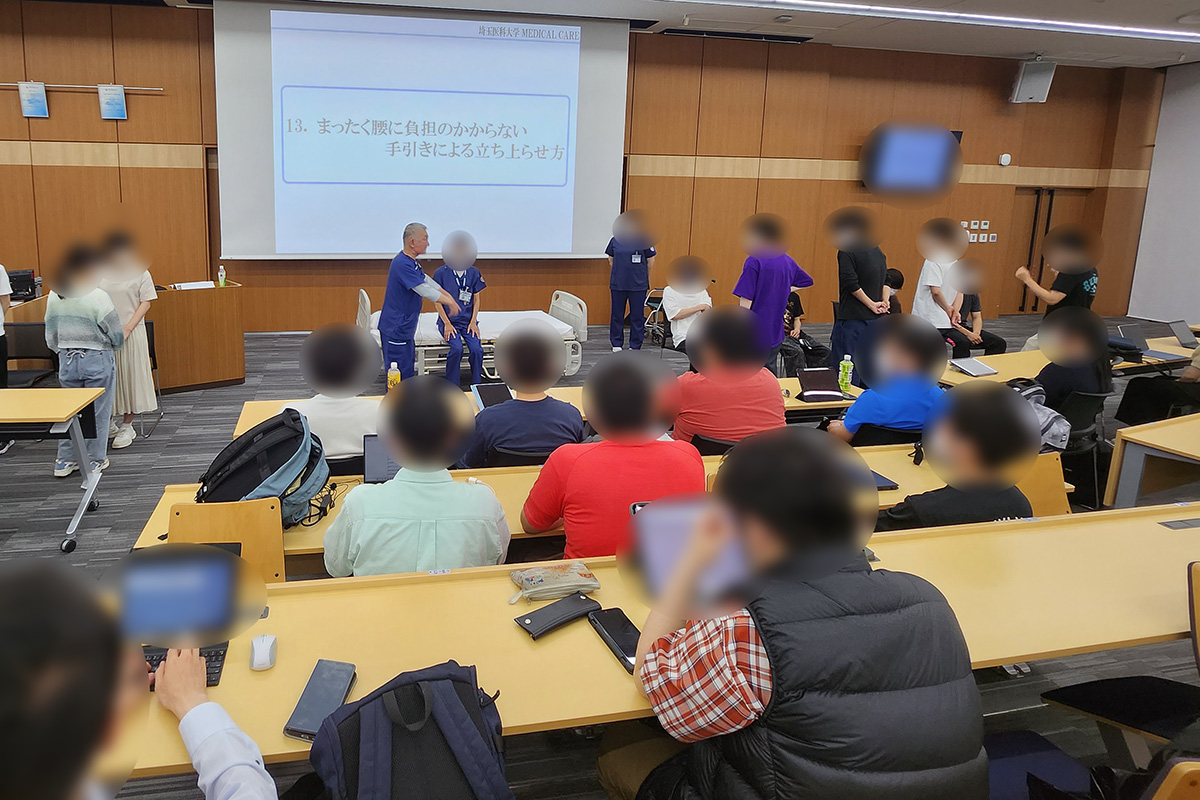Prof. Nezu gave the final class of "First Semester" for first and second year students of the School of Medicine at Saitama Medical University.

On June 19, 2023, Prof. Nezu gave the final class of "First Semester" for first and second year students of the School of Medicine at Saitama Medical University.
The required elective classes for first and second year students at Saitama Medical University are divided into the first semester, which runs from April to July, and the second semester, which runs from September to December. On this day, he gave the students a summary of the lecture on caregiving technique given in the first semester in a very easy-to-understand manner.

On the day of the class, the chairperson and vice chairperson of the executive committee of "EKKASAI," a university festival held jointly by the School of Medicine and the School of Health Sciences of Saitama Medical University in the fall, came to observe the class. They wanted to hold an event of Prof. Nezu's caregiving technique for the community at this year's "EKKASAI". This is a great social contribution to the neighborhood that the students are making, and Prof. Nezu has graciously agreed to provide the students with instruction in caregiving technique.

I am convinced that the solidarity between faculty members and students of Saitama Medical University will be further deepened by the participation of not only doctors and nurses but also students in spreading the caregiving techniques developed by Prof. Nezu in the community, and that Saitama Medical University will truly be able to make a concerted effort to contribute to society and the community.
(Reported by Associate Dean of Saitama Medical University)
<Feedback from students>
■S, 1st year student
The term "declining birthrate and aging population" was striking for all but the developing countries. I had a strong image of Japan as a super-aging society with a rapidly falling birthrate and aging population, but I was shocked to see this happening in other developed countries as well. I was also surprised that at this point in time, nurses are already not present when patients are examined in some departments. I realized that there is a problem of nursing care in the very near future. I realized that doctors will also need assistive technology and that nurses may have to leave their jobs because of the strain on their backs. Since I was able to perform assisting techniques that I had never learned or practiced before, I would like to learn them so that I can use them in the future. I would also like to remember the points of relaxing in case I have to assist people close to me in the future, in addition to being a doctor.
I also realized once again that patients reject without realizing it, that it is important to touch them rather than hold or grasp them, and that it is difficult to relax, but if I do not relax, the patient will not be able to relax and the burden will become heavier.
■T, 1st year student
The lecture on assisting techniques in medical treatment (Saitama Medical University Style: Comprehensive Skills for Caregiving that Require No Strength) focused on assisting techniques that do not require unnecessary force, enabling participants to acquire the most effective and easy-to-implement assisting methods in the medical field.
In the lecture, various methods were introduced to provide assistance that is different from conventional assistance and does not require unnecessary force. The methods are characterized by taking into account the patient's own physical strength and the repulsive force received from the patient. For example, when grasping a patient's arm, instead of gripping it stiffly, the patient is grasped his arm softly using three fingers. This is not only to reduce the pain felt by the patient, but also to reduce the repulsive force. This is just one example, but I believe that the techniques taught will reduce the burden on caregivers and further improve patient comfort and safety.
Through the lecture on assisting techniques in the clinic, I learned a lot about assisting without using force, and I was able to learn it physically. This technique will be very beneficial to me as a future doctor, as it will improve the quality of care for the benefit, comfort, and safety of the patient. On a different note, I believe that in the future Japan will enter a society with a very low birthrate and an aging population. In such a society, doctors will naturally need to provide care. For this reason, I would like to proactively adopt the “Nezushiki Kaigogijutsu” that does not require force, and I would like to build a better medical environment while reducing the burden on patients.
■T, 1st year student
In today's lecture, we experienced two methods of standing up from a sitting position and three methods of holding a position in a standing position: side, face-to-face, and rear type. In particular, the person with whom I assisted in standing up from a sitting position was heavier than I was, so I was able to experience the most amazing assistance among all the methods I have experienced so far. I wondered more than ever if I could really help the person stand up, because even if I tried to put my arms behind his body, the person who weighed more than I did had a bigger body and my arms would not go behind his body. However, I was able to stand up so easily that I thought that a person who weighed more than me would be able to stand up more easily. I had been assisting with people of about the same size, so this was a wonderful experience for me at the end of the day. I thought that this would be the last time I would be able to learn from Prof. Nezu, and like the student he mentioned, I wanted to take the class again, but since that is not possible, I would like to review the content of the class so that I can apply what I have experienced so far in the future. I would also like to do my best to become a doctor like Prof. Nezu, who faces patients with the sole intention of saving them.
■Y, 2nd year student
Today was a comprehensive review of back-strain-free assisting techniques.
First, we reviewed the five basic movements (push, pull, turn, touch, and change the fulcrum) and the six directions in which a person falls (three forward and three backward), and then we practiced the techniques we had learned in the previous classes. We also learned how to transfer a patient from a stretcher to a bed, how to help a patient who has difficulty raising his/her arms stand up from a chair, and how to move a patient in a wheelchair when the patient is sitting too shallowly. The method of transferring a patient from a stretcher to a bed without putting strain on the back and with a minimum number of people is a technique that will be very useful after becoming a doctor, so I felt that I would like to learn and practice it. Although transferring a patient is a very strenuous operation that requires at least four people to perform, I was quite impressed that two women were able to carry a male student so easily. All the other assisting techniques we have learned so far were also able to be performed without any burden, and I think it would be quite an advantage if we could be practiced in the medical field. I think that if we can replace conventional power nursing care with assistance that does not require force, it will be easier on both the patient and the caregiver, and will reduce physical fatigue. As the professor mentioned today, there are times when a nurse is not available to assist a doctor due to a shortage of staff, so I would like to make use of what I have learned so that I can smoothly provide assistance even when I am alone.
Thank you very much for taking time out of your busy schedule to teach us many useful assisting techniques.
■Y, 2nd year student
There is only one elective required class left. Due to the teacher's physical condition, the opportunity to receive direct instruction is precious. I am impressed when I actually experience it, and I learn more from it than from listening to Prof. Nezu talk about it.
With exams coming up, it may seem that the second-year students in particular, including myself, are not really into the class, but when we paired up in front of the lecture room to practice, we heard comments like "I really didn't need to exert any effort! I didn't feel any pain and it didn't burden me! We were talking to each other about how we liked it. Thank you very much for your kind and patient talk and guidance to us.
Five years from now, when I try to use the assisting techniques, I may have forgotten some things in my head because it has been so long, but I am sure my body will remember. I would like to tell my friends who did not choose this class, as well as doctors, nurses, and other healthcare professionals from other universities, that there are such wonderful assisting techniques! and if we can read the book together, remember, practice, and spread the word, I think we will be at the starting line.Thank you very much.



